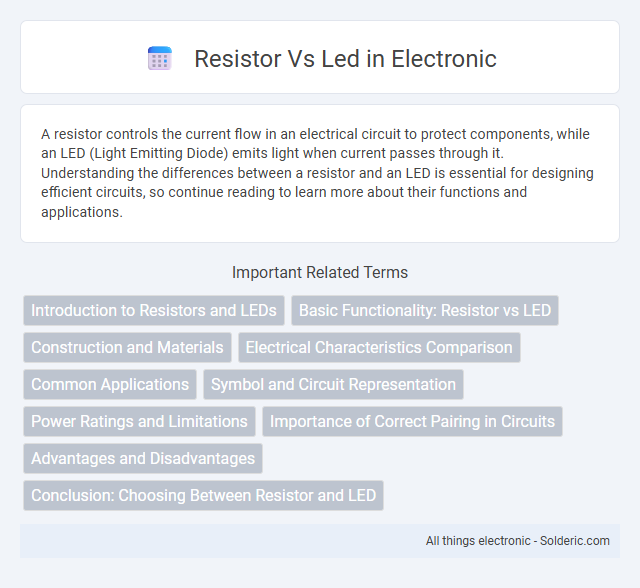A resistor controls the current flow in an electrical circuit to protect components, while an LED (Light Emitting Diode) emits light when current passes through it. Understanding the differences between a resistor and an LED is essential for designing efficient circuits, so continue reading to learn more about their functions and applications.
Comparison Table
| Feature | Resistor | LED (Light Emitting Diode) |
|---|---|---|
| Function | Limits electric current in a circuit | Emits light when current flows through it |
| Component Type | Passive electronic component | Active semiconductor device |
| Symbol | zig-zag line | diode symbol with arrows pointing outward |
| Electrical Behavior | Obeys Ohm's Law (V=IR) | Forward voltage drop; emits photons |
| Typical Voltage Drop | Varies (depends on resistance) | 1.8V to 3.3V depending on LED color |
| Current Handling | Set by resistance value, usually in ohms (O) | Limited by forward current, typically 20mA |
| Usage | Control current, divide voltage, signal conditioning | Indicator lights, displays, lighting |
| Power Dissipation | Converts electrical energy to heat | Converts electrical energy to light and heat |
| Polarity | Non-polarized | Polarized (requires correct orientation) |
Introduction to Resistors and LEDs
Resistors and LEDs serve distinct but complementary roles in electronic circuits; resistors control the current flow to protect sensitive components, while LEDs emit light when current passes through them. Your circuit's performance depends on selecting the right resistor value to ensure the LED operates within its specified current range, preventing damage and ensuring optimal brightness. Understanding the electrical characteristics of both components is essential for designing efficient and reliable electronic devices.
Basic Functionality: Resistor vs LED
A resistor regulates electrical current by providing a specific resistance level to control voltage flow in circuits, ensuring other components operate safely. An LED (Light Emitting Diode) converts electrical energy into light when current passes through it, serving as an indicator or illumination source. Your circuit often requires a resistor in series with an LED to limit current and prevent damage to the LED due to excessive power.
Construction and Materials
Resistors are typically constructed using carbon film, metal oxide, or wire-wound materials designed to limit electric current by providing resistance. LEDs consist of semiconductor materials such as gallium arsenide or gallium nitride, which emit light when an electric current passes through them. Understanding the construction differences between your resistor and LED will help optimize circuit design and ensure proper component selection.
Electrical Characteristics Comparison
Resistors exhibit a linear current-voltage relationship defined by Ohm's law, offering constant resistance across a wide voltage range, whereas LEDs demonstrate a nonlinear voltage-current characteristic, requiring a specific forward voltage (typically around 2V for standard red LEDs) to conduct significant current. Resistors dissipate power as heat based on current flow, while LEDs convert electrical energy into light and heat, with power consumption dependent on forward current and voltage. The electrical behavior of LEDs demands careful current limiting, often achieved by placing a resistor in series, to prevent excessive current that damages the diode.
Common Applications
Resistors and LEDs are commonly used together in electronic circuits to control current flow and provide visual indicators. Resistors regulate voltage and current levels to protect LEDs from damage during operation. LEDs are widely applied in display panels, indicator lights, and signaling devices, while resistors find use in voltage division, current limiting, and circuit stabilization across various electronic applications.
Symbol and Circuit Representation
The resistor symbol is typically a zigzag line or a rectangle, whereas the LED (Light Emitting Diode) symbol combines a diode arrow with two small arrows indicating light emission. In circuit diagrams, resistors are used to limit current flow, and LEDs are positioned to emit light when current passes through them, often with a resistor placed in series to protect the LED. You should always include a resistor with an LED in your circuit to prevent damage from excessive current.
Power Ratings and Limitations
Resistors used with LEDs must have appropriate power ratings, commonly 0.25W to 0.5W for standard indicator LEDs, to safely dissipate energy without overheating. LEDs have power limits defined by their maximum forward current and voltage, typically around 20mA and 2-3V for standard types, beyond which damage or reduced lifespan occurs. Selecting a resistor with suitable wattage ensures controlled current flow, protecting LEDs from excessive power and thermal stress.
Importance of Correct Pairing in Circuits
Correct pairing of resistors and LEDs in circuits ensures optimal current flow, preventing LED damage caused by excessive current. Using an appropriate resistor value controls the voltage drop across the LED, maintaining its brightness and extending its lifespan. Failure to match resistor specifications with LED requirements can result in circuit malfunction or reduced component reliability.
Advantages and Disadvantages
Resistors regulate current flow to protect LEDs from damage, making circuits safer and more reliable, but they can cause power loss through heat dissipation. LEDs offer energy efficiency and long lifespan with bright, focused light output, yet they require careful current control and are sensitive to voltage fluctuations. Your choice depends on prioritizing protection and stability (resistor) or energy efficiency and brightness (LED).
Conclusion: Choosing Between Resistor and LED
Choosing between a resistor and an LED depends on your circuit's function and requirements; resistors control current flow, protecting components like LEDs from damage. LEDs serve as indicators or emit light when powered, but require appropriate resistors to regulate current and prevent burnout. Your selection must balance circuit protection with desired visual output to ensure optimal performance.
resistor vs led Infographic

 solderic.com
solderic.com